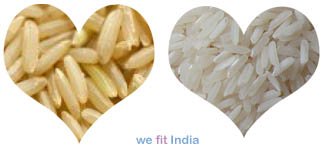
Rice feeds the world! Over three billion people worldwide depend on rice for over half of their daily total calorie intake and is the most familiar food eaten in grain form. Rice is commonly served as a side dish in American households, but elsewhere it forms the basis for most meals. In fact, half the world’s peoples eat rice as their stable food. Unfortunately, this important food source is usually eaten in most parts of the world in its least nourishing form – that is, milled and polished which removes its valuable nutrients.
Milling is the process that creates the difference between brown and white rice. The variety of rice may be identical, but milling removes the husk from the grain and turns the brown rice to white. This is why milling is often called “whitening”. Brown rice is the whole rice grain with just the first outer layer (husk or hull) removed through milling. It retains its fibre and germ which contains vital nutrients. White rice is brown rice that has been milled to remove the bran and much of the germ, reducing fibre and nutrient content leaving mostly the starchy endosperm. The grain is further polished to take away the remaining layer of germ (called the aleurone layer) which contains essential oils. These oils are what oxidize and go rancid, so removing them makes white rice stored for longer.
In the United States because of the guidelines set by the Food and Drug Administration White rice is enriched with two Vitimins B – Thiamin and Niacin and Iron. But in many countries where it constitutes the bulk of the diet, enrichment is not a common practice.
Here are some of the Benefits of Brown Rice over White Rice
Increases Metabolic Rate/Weight Loss
Brown rice assists weight loss and reduces metabolic problems. Eating whole grains with lots of fibre, like brown rice, helps with maintaining optimal weight. Intake of White rice or refined grains have been linked to weight gain, type two diabetes, and metabolic syndrome.
Controls Diabetes
According to a new study replacing White rice in your diet with Brown rice may reduce the risk of developing type 2 diabetes. People who consume five or more servings of white rice per week have a 17% increased risk of diabetes compared to people who eat less than one serving per month. On the contrary eating two or more servings of Brown rice per week is associated with an 11% reduced risk of developing type 2 diabetes.
Controls Cholesterol levels
When rice is milled and polished the bran portion of the grain is removed. Like Oat bran, rice bran enjoys the reputation as a cholesterol fighter. Researchers at the USDA have found that rice bran lowers blood cholesterol in animals just as much as oat bran.
Low Glycemic Index
White rice has a higher Glycemic index (GI) than brown rice. GI is a measure of how fast a particular food raises blood glucose levels. Researchers attribute the high GI value of white rice to the disruption of physical and botanical structure of rice grains during the refining process. The other consequence of the refining process includes loss of fibre, vitamins, magnesium and other minerals many of which may be protective factors for diabetes risk.
Research shows that after eating white rice once digested the blood sugar levels boost high and insulin has to be released to control the blood sugar levels. But when Brown Rice is eaten, it digests slowly with fibre layer on top and it gradually releases the sugar so blood sugar is within normal levels. So body doesn’t have to release insulin to control blood sugar. This way it guarantees you that you will not be diabetic in future. Estimated Glycemic load (GL) for brown rice is 11 which is better than white rice with Glycemic load of 15.
Good source of Fibre
Brown rice contains nutrients like magnesium, manganese and zinc. White rice has fewer amounts of these nutrients, but is fortified with iron and some B vitamins. Brown rice is the only form of the grain that contains vitamin E. Brown rice has more fibre than white rice, and the difference is due to the way both types are processed. The bran is kept intact in brown rice, and that bran gives you a healthy dose of fibre. The daily requirement for fibre for adults up to age 50 is 38 g for males and 25g for females. Fibre also helps out by keeping blood sugar levels under control, so brown rice is an excellent grain choice for people with diabetes. When researchers looked at how much fibre 35,972 participants in the UK Women’s Cohort Study ate, they found a diet rich in fibre from whole grains, such as brown rice, and fruit offered significant protection against breast cancer for pre-menopausal women.
Good for Bones
Magnesium is another nutrient for which brown rice is a good source, has been shown in studies to be helpful for reducing the severity of asthma, lowering high blood pressure, reducing the frequency of migraine headaches, and reducing the risk of heart attack and stroke. Magnesium, as well as calcium, is necessary for healthy bones. About two-thirds of the magnesium in the human body is found in our bones. Brown rice helps you keep those Magnesium storage sites replenished and ready to meet your body’s needs. A cup of brown rice will give you 21.0% of the daily value for magnesium.
Other Health Benefits
The complete milling and polishing that converts brown rice into white rice destroys 67% of the vitamin B3, 80% of the vitamin B1, 90% of the vitamin B6, half of the manganese, half of the phosphorus, 60% of the iron, and all of the dietary fibre and essential fatty acids. Brown rice is a healthier choice than white rice for most people due to brown rice’s higher fibre, magnesium and zinc content. One cup (195 g) of cooked long grain brown rice contains 84 mg of magnesium while one cup of white rice contains 19 mg.
Brown Rice Vs. White Rice – long grain 100 g cooked
| Brown Rice | White Rice | |
| Basics | ||
| Calories | 111 | 130 |
| Protein | 2.58 g | 3 g |
| Carbohydrate | 22.96 g | 28 g |
| Fat | 0.9 g | 0 |
| Cholesterol | 0 | 0 |
| Fibre | 1.9 g | 0 |
| Water | 73.09 g | 68.4 g |
| Fats and Fatty Acids | ||
| Total Fat | 0.9 g | 0.3 g |
| Saturated Fat | 0.2 g | 0.1 g |
| Monounsaturated Fat | 0.33 g | 0.1 g |
| Polyunsaturated Fat | 0.32 g | 0.1 g |
| Total Omega-3 fatty acids | 14 mg | 13 mg |
| Total Omega-6 fatty acids | 309 mg | 62 mg |
| Vitamins | ||
| Vitamin A | 0.0 IU | 0.0 IU |
| Vitamin C | 0.0 mg | 0.0 mg |
| Vitamin D | – | – |
| Vitamin E (Alpha Tocopherol) | 0.0 mg | 0.0 mg |
| Vitamin K | 0.6 mcg | 0.0mcg |
| Thiamin | 0.1 mg | 0.2 mg |
| Niacin | 1.5 mg | 1.5 mg |
| Vitamin B6 | 0.1 mg | 0.1 mg |
| Folate | 4.0 mcg | 58.0 mcg |
| Vitamin B12 | 0.0 mcg | 0.0 mcg |
| Pantothenic Acid | 0.3 mg | 0.4 mg |
| Choline | 9.2 mg | 2.1 mg |
| Betaine | 0.5 mg | 0.5 mg |
| Minerals | ||
| Calcium | 10.0 mg | 10.0 mg |
| Iron | 0.4mg | 1.2 mg |
| Magnesium | 43.0 mg | 12.0 mg |
| Phosphorus | 83.0 mg | 43.0 mg |
| Potassium | 43.0 mg | 35.0 mg |
| Sodium | 5.0 mg | 1.0 mg |
| Zinc | 0.6 mg | 0.5 mg |
| Copper | 0.1 mg | 0.1 mg |
| Manganese | 1 mg | 0.5 mg |
| Selenium | 9.8 mcg | 7.5 mcg |
1 gram of fat in Brown rice is really nothing to worry about, even if you consume 2 servings. When you weigh the differences of White rice to Brown rice the health benefits are extremely in the favor of Brown rice. Cooking times vary between brown and white rice, so convenience may be one of the advantages of White rice. Preparation of the White rice variety takes about 10 to 15 minutes to cook while whole-grain brown rice takes a bit longer and requires more water in the pot. White rice easily accommodates the flavours of other ingredients in a recipe, whereas brown rice has a distinctive nut-like flavour that may overpower rather than blend in with other ingredients. If you are otherwise healthy, feel free to eat modest portions of white rice occasionally. If you have days where you suffer bloating or indigestion, you may find that you can digest white rice more easily than brown rice.






















